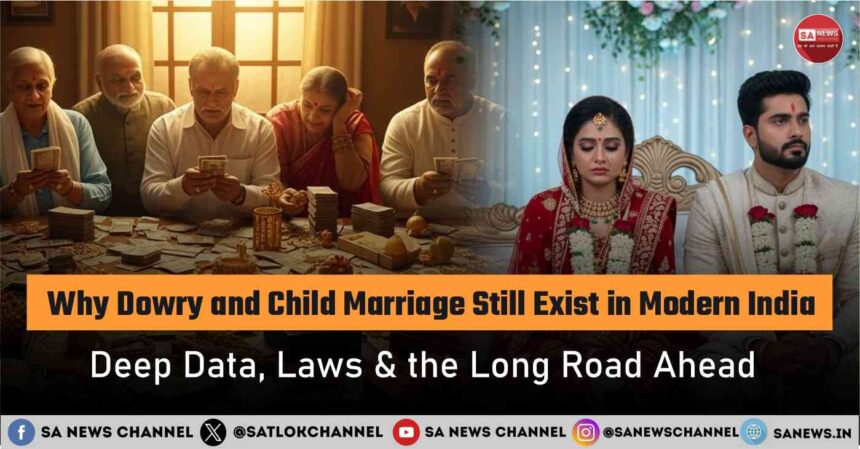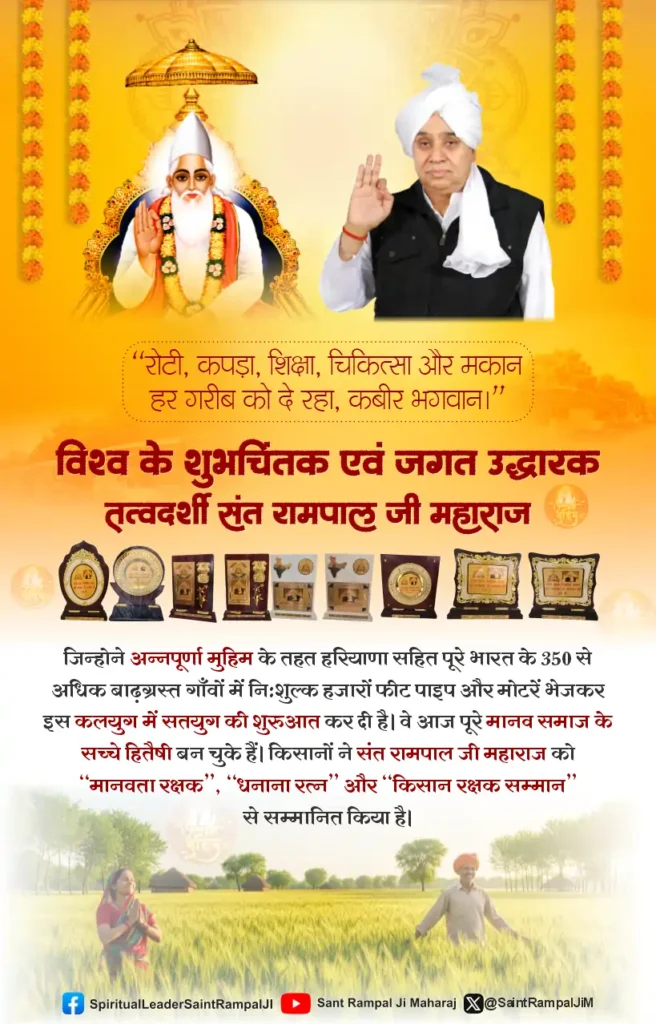India has come a long way in terms of education, infrastructure, and women’s rights. Yet two deep-rooted social evils — child marriage and dowry — continue to persist, causing untold suffering. What do the numbers tell us? What laws and schemes exist? And why, despite all that, do these practices still survive?
- Highlights:
- Historical & Statistical Background
- Child Marriage
- Dowry
- Legal & Government Measures (Past & Present)
- Key Laws
- Government Schemes & Campaigns
- Ladli Laxmi Yojana (Madhya Pradesh and other states):
- Recent / State-level Innovations
- Why These Evils Still Survive: Root Causes & Challenges
- Recent Data Highlighting the Problem (2022-2023)
- For dowry in 2023:
- Recent Data Highlighting the Problem (2024-2025)
- 1. Child Marriages Stopped / Prevented (2024-2025)
- 2. Child Marriages Still Occurring in Specific Regions
- 3. Dowry-Related Deaths & Increase in Dowry Cases
- 4. Rise in Registered Child Marriage Cases under Law
- 5. Drivers of Child Marriage (2024-2025 Reports)
- 6. Districts Declared Child Marriage-Free
- Government Prevention: Effectiveness & Gaps
- What More Needs to Be Done
- 1. Stronger law + reform
- 2. Better enforcement
- 3. Faster justice
- 4. Awareness & Social Change
- 5. Economic Empowerment
- 6. Monitoring & Data Transparency
- 7. Spiritual / Moral Education
- Possible Future Scenario: What Could Change by 2030
- What Is the Solution to the Dowry System?
- Dowry Quotes
- Marriages Completed without Dowry From Guruvani in 17 Minutes
- Anti Dowry Movement (Dowry Free India): What Is Ramaini?
- Conclusion
Highlights:
- Dowry still demands the lives of thousands of women every year.
- One in five girls in India is married before turning 18.
- Education alone hasn’t changed deep-rooted social beliefs.
- True awareness must begin from moral and spiritual awakening.
Historical & Statistical Background
Child Marriage
In 2005-06, about 47.4% of women aged 20-24 in India were married before they turned 18.
By 2015-16, this proportion dropped to ~26.8%.
Most recent data (NFHS-5, 2019-21) shows ~23.3% of women aged 20-24 are married before 18.
However, the drop in the last 5 years has been slower — from ~26.8% down to 23.3%, indicating a plateau in progress.
The issue is not evenly spread: many states (e.g. Bihar, West Bengal, Tripura, Assam, Jharkhand) have rates well above national average. Also, certain districts (259 in total) report child marriage rates higher than the national average.
A recent figure: “2 lakh child marriages prevented during the past year,” announced under the Bal-Vivah Mukt Bharat campaign. Yet “one in five girls still wed below the legal age of 18.”
Dowry
The Dowry Prohibition Act, 1961 outlawed the giving or taking of dowry. However, enforcement has always been a challenge.
Over time, the law got amended / strengthened, social awareness increased, and legal definitions broadened.
Recent NCRB data (Crime in India, 2023) shows 15,489 cases registered under the Dowry Prohibition Act. This is up from ~13,479 in 2022 and ~13,568 in 2021.
Dowry deaths are very high: 6,156 deaths in 2023, with Uttar Pradesh, Bihar topping numbers.
Convictions are low; many cases are pending trial, many do not complete.
Legal & Government Measures (Past & Present)
To understand why dowry and child marriage still persist, it’s important to look at what laws and government policies exist, how they have evolved, and what new ones are being proposed.
Key Laws
1. Child Marriage Restraint Act, 1929 (Sarda Act)
First major law to limit child marriage under British Raj. Set age for girls at 14, boys at 18.
Amended in 1949 (girls’ minimum age to 15), and in 1978 to set girls’ minimum age to 18, boys to 21.
2. Prohibition of Child Marriage Act (PCMA), 2006
Replaced the older Child Marriage Restraint Act. Makes child marriage illegal, and also provides protection & relief to victims. It also mandates the appointment of Child Marriage Prohibition Officers.
Amendments proposed: In 2021, a Bill was introduced to raise the legal age of marriage for women from 18 to 21 years to equalize with men. This is under parliamentary consideration.
3. Dowry Prohibition Act, 1961
Law banning giving/taking of dowry, with penalties for violation. Has been amended over the years to strengthen the law.
4. Other supporting laws / measures:
Commissions for Protection of Child Rights Act, 2005: Provides for national/state commissions, children’s courts.
Criminal laws: IPC sections for dowry death (Section 304B), cruelty by husband/relatives (498A), etc.
Government Schemes & Campaigns
Bal-Vivah Mukt Bharat / Child Marriage Free Bharat:
Launched by Ministry of Women & Child Development. Goal: reduce child marriage rates to below 5% by 2029 in high burden states and districts. Community engagement + reporting systems.
Beti Bachao, Beti Padhao:
A national campaign started in 2015 aimed at improving the status of girls (education, sex ratio, etc.). While not directly targeted only at child marriage, it contributes to reducing it by changing social mindset.
Ladli Laxmi Yojana (Madhya Pradesh and other states):
Provides incentives for girls’ education and financial support; aims to improve their economic value within the family and reduce early marriage.
Recent / State-level Innovations
Assam: Strong enforcement in 2023 led to a 54% drop in child marriages since 2023 (as per state government), with crackdowns, arrests, appointment of Child Marriage Prohibition Officers in villages.
Karnataka: Proposed amendment in 2025 to criminalise engagements involving minors (i.e., even before marriage) to prevent bypassing the law.
Why These Evils Still Survive: Root Causes & Challenges
Even with laws and schemes, dowry and child marriage continue. Here are reasons why they persist.
1. Poverty and economic insecurity
For many families, marrying off daughters early is seen as a way to reduce the burden (economic and social).
Dowry is often viewed as a “necessary cost” of marriage — families feel pressured to give gifts, property, cash to secure “good match,” despite the law.
2. Social norms, tradition, patriarchy
Deep-rooted beliefs about honor, gender roles, male dominance.
Social pressure: fear of what neighbours will say, maintaining status.
Practices are often disguised: what is demanded as “gift” is often dowry, but socially acceptable.
3. Weak enforcement and under-reporting
Many cases are not reported due to stigma, threats, or families wanting to avoid legal trouble.
Even when reported, many cases remain pending and get delayed in courts. Conviction rates are low.
Officials, police, local authorities may be complicit or insensitive.
4. Lack of awareness / education
Some families do not fully understand the laws, or believe that laws do not apply to them or their religion / caste.
Education of girls helps — but even educated families sometimes act under social pressure.
5. Legal loopholes or delay in reform
Raising the age of marriage for women to 21 is still a proposal, not law in many places.
Some practices (like grooming, engagements, “gift culture”) circumvent the spirit if not the letter of the law.
6. Gender inequality & economic dependence
Many women are economically dependent on families / husbands → less power to resist demands.
Kerala, Maharashtra, urban India show better rates, but rural areas lag.
Recent Data Highlighting the Problem (2022-2023)
In 2022, over 2 lakh child marriages were prevented under various actions, yet “one in five girls” still get married before age 18.
For dowry in 2023:
15,489 cases registered under Dowry Prohibition Act.
6,156 people died in dowry-related deaths in 2023.
Uttar Pradesh, Bihar are leaders in both number of cases and deaths.
Child marriage rates have declined globally and in India, but decline has slowed in recent years. NFHS-5 shows ~23.3%.
Recent Data Highlighting the Problem (2024-2025)
1. Child Marriages Stopped / Prevented (2024-2025)
From April 1, 2024 to March 31, 2025, across 416 districts in 23 states, over 1,351 child marriages were stopped and 1.22 lakh (122,000+) were prevented through legal and community interventions.
In those 1,351 stopped marriages:
• 737 were stopped by registering a General Diary with the police
• 593 cases involved Child Welfare Committee intervention
• 21 cases involved court-ordered injunctions
In the prevented group (1.22 lakh+), many were halted through parental/guardian undertakings before authorities (police, child marriage prohibition officers, panchayat members etc.)
2. Child Marriages Still Occurring in Specific Regions
Belagavi district in Karnataka reported 42 child marriages between April 2024 and March 2025; out of 196 attempted marriages, 154 were prevented, but these 42 occurred anyway.
Kuruba community in Belagavi had the highest number of cases (37).
3. Dowry-Related Deaths & Increase in Dowry Cases
According to the NCRB Crime in India 2023 report (recently released), 15,489 cases were registered under the Dowry Prohibition Act in 2023. This is 14% higher than the previous year (2022).
6,156 people died in dowry-death cases in 2023.
Top states in dowry mortality: Uttar Pradesh (2,122 deaths), Bihar (1,143 deaths) in 2023.
4. Rise in Registered Child Marriage Cases under Law
NCRB data shows a six-fold rise in actual cases registered under the Prohibition of Child Marriage Act in 2023: 6,038 cases in 2023 vs. 1,002 in 2022.
But note: About 90% of these cases in 2023 were from Assam alone (5,267 out of 6,038). Other states reported far fewer.
5. Drivers of Child Marriage (2024-2025 Reports)
A recent multi-state survey (Bihar, Rajasthan, Assam, Karnataka, Maharashtra) found that poor financial condition is the most dominant driver of child marriage. ~91% of respondents cited economic hardship.
Also cited were cultural practices and perceived need for protection for girls.
6. Districts Declared Child Marriage-Free
Balod district, Chhattisgarh, was officially declared child marriage-free in late 2024 under the Child Marriage-Free India campaign, after no reported case over two consecutive years across all its gram panchayats and urban bodies.
Also, 75 village panchayats in Surajpur district gained the same status after going two years without any child marriage cases.
Government Prevention: Effectiveness & Gaps
What the government has done right, and what still needs improvement.
Positive Impacts
Laws like PCMA (2006) and Dowry Prohibition Act have created legal basis and deterrents. Some high-profile cases are prosecuted.
Campaigns have raised awareness; families in some states are being more cautious.
State initiatives (Assam, Karnataka) show that strong local enforcement + community engagement can lead to measurable drop in cases.
Financial/incentive schemes (Ladli Laxmi, Beti Bachao Beti Padhao) help reduce the economic pressure and raise the value of girls in families.
Weaknesses & Challenges
Conviction rates are low. Many cases remain pending in courts for years.
Underreporting: Many child marriages and dowry harassment never reach legal record; families settle informally or avoid attention.
Legal reforms are slow: e.g. raising the age of marriage for women to 21 is proposed but not universally accepted or enacted.
Enforcement disparity: Some states are very active, others much less. Some districts see a large number of high-burden child marriages; others not.
Cultural resistance: Traditions are powerful. Even when people know the law, social and family pressure often override legal fear.
Resource & administrative limitations: lack of manpower, weak implementation of laws at the ground level (police, village officers), corruption or apathy.
What More Needs to Be Done
To finally push these practices into serious retreat, beyond the laws already in place, India needs:
1. Stronger law + reform
Pass the amendment raising women’s legal marriage age to 21 uniformly across all personal laws and states.
Make engagements of minors punishable (like Karnataka is doing) so that child marriage is not bypassed via betrothal.
2. Better enforcement
Ensure Child Marriage Prohibition Officers work effectively in every district, monitor, register attempts, stop ceremonies.
Marriage halls, invocation of religious places verify age; registration of marriages is made compulsory and transparent.
3. Faster justice
Fast-track courts / special benches should be set up for child marriage and dowry-related cases.
Penalize not just the immediate perpetrators but those who facilitate or enable (matchmakers, priests, witness)
4. Awareness & Social Change
Mass awareness campaigns in local languages, using respected community leaders, influencers.
Expand school curriculum to include gender equality, legal rights, value of girls, etc.
5. Economic Empowerment
Income generating skills, vocational training for girls.
Financial incentives / scholarships to keep girls in school.
6. Monitoring & Data Transparency
More granular data (by district, caste, religion, socio-economic class) so interventions can be targeted.
Digital platforms to register/report child marriage/dowry harassment anonymously.
7. Spiritual / Moral Education
Encouraging values of compassion, respect for human dignity, equality through spiritual teaching.
Highlighting stories / teachings that show how social evils are disconnected from true moral/spiritual success.
Possible Future Scenario: What Could Change by 2030
If the right steps are taken, India could see:
Child marriage rates dropping below 5% in high burden states (goal of Bal-Vivah Mukt Bharat).
Dowry death cases reducing significantly if enforcement improves, social expectations shift.
Legal age of marriage for women equalised with men, reducing gender-based discrimination.
More women in education, employment, having economic agency.
But this will require commitment across government, civil society, and families.
What Is the Solution to the Dowry System?
Dowry Free India: The solution to the dowry system seems to be out of the reach of most governments, organizations, and religious sects — except for the renowned Saint Rampal Ji Maharaj from Haryana. Saint Rampal Ji has demonstrated a spectacular dowry free marriage initiative called Ramaini that doesn’t accept any exchange of dowry. The success of this anti-dowry movement is based on the discipline maintained by the disciples of Saint Rampal Ji Maharaj under His leadership, strictly prohibiting any exchange of dowry. This is unique in itself. This kind of anti dowry movement can be fruitful in abolishing such a curse from society that has taken the lives of many innocent women.
Dowry Quotes
- Either Dowry in Hinduism or Dowry in Islam or Dowry in Christianity or Dowry in Sikhism, Dowry is a curse for the society and for upcoming generations.
- It is a misconception that marriage will work only with a good dowry. Dowry is just a man-made criteria of judging a girl’s family which is completely wrong in itself.
- Dowry is similar to the pack of cigarettes, it is killing people and still people are practicing it.
- Dowry, settled into the roots of Indian society, can be eliminated by awareness about true spiritual knowledge given by a Complete Saint.
- Dowry Free marriages conducted by Saint Rampal Ji Maharaj have demonstrated that honesty still exists in people, the only need is to understand the difference between right and wrong by understanding His True Spiritual Knowledge.
Marriages Completed without Dowry From Guruvani in 17 Minutes
On one hand, while the whole world is increasing the misery of themselves and their daughters by taking or giving dowry, Sant Rampal Ji Maharaj’s disciples support the eradication of the dowry system by marrying through the Ramaini ceremony. Every day hundreds of people get married by Ramaini in all the ashrams of Sant Rampal Ji Maharaj across the world.
Anti Dowry Movement (Dowry Free India): What Is Ramaini?
Jagatguru Sant Rampal Ji Maharaj preaches in His sermons to adopt the noble virtues like Eternal Knowledge, Conscience, Contentment, Love, Endurance, Kindness, Forgiveness, Modesty, Renunciation, Disinterest, Peace, Religion, Devotion, Equanimity. The great saint has taken effective steps against social evils. He has devised an innovative method of the dowry free marriage ceremony, popularly known as Ramaini, which takes only seventeen minutes without any exchange of money and commodities as dowry. There is no pomp and show, and this way His devotees not only save money but also valuable time.
FAQs
Q1: What is the legal age of marriage in India currently?
For women, it is 18 years; for men, it is 21 years. (Under current PCMA). There are proposals to raise the female age to 21 to match men.
Q2: What is “dowry death”?
Dowry death (Section 304B of IPC) refers to death of a woman caused by harassment or cruelty by husband or his relatives over dowry demands. If fulfilled, legal action under Dowry Prohibition Act + other penal sections can follow.
Q3: What punishments exist for dowry and child marriage?
Those who solemnize or promote child marriages can face penalties under the PCMA.
Dowry Prohibition Act prohibits giving, taking, or demanding dowry—penalties include imprisonment and fines.
IPC sections like 304B (dowry death), 498A (cruelty by husband or relatives) also apply.
Q4: Why do some people support raising the marriage age for women?
To align with male age, give women more time for education, maturity, reduce harms from early pregnancy, improve equality. Critics worry about enforcing such law in rural/traditional settings, or unintended consequences.
Q5: Can culture/religion justify child marriage or dowry?
Laws are clear: no. The Constitution of India prohibits discrimination, and laws (PCMA, Dowry Prohibition Act) are secular. Religious or cultural justification does not override the law. Over time, many religious leaders have also spoken against these practices.
Q6: How can I get married without dowry?
You can get married without a dowry by mutual understanding and by listening to the satsang of Sant Rampal Ji Maharaj. Today all His devotees are organising dowry free marriages.
Conclusion
Dowry and child marriage are not relics of the past—they continue to harm millions in India even today. The data shows progress, but also reveals how slow and uneven that progress has been. Legal frameworks, government schemes, and public awareness campaigns have made a difference, but enforcement is weak, cultural pressure is strong, and many practices survive because people don’t yet see them as intolerable.
For real change, we need a combined strategy: stronger laws, quicker justice, economic empowerment, and a shift in social values. When families begin to see daughters not as burdens but as equals; when society honors equality more than tradition; and when spiritual/moral wisdom (SatGyan) promotes compassion over control—only then will child marriages and dowry fade into India’s history, rather than its daily news.









